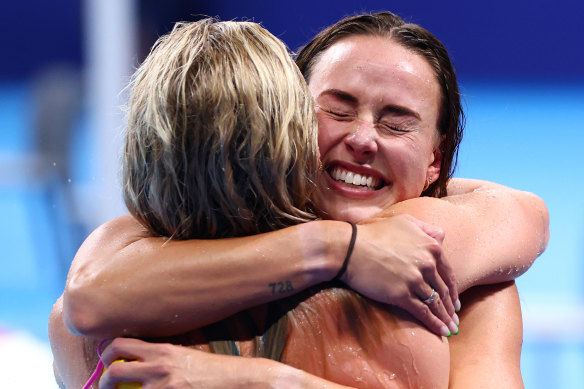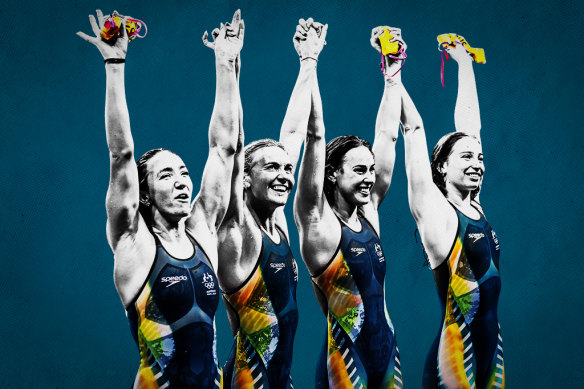Opinion
Even better than gold, these Olympians have shown Aussie girls anything is possible
Shona Hendley
Writer“And here I am, from little old Lonnie, a town of 90,000, and I’m out here living the dream, so I hope that inspired kids back home.”
These were the words of Olympic gold medallist Ariarne Titmus, spoken minutes after she won the women’s 400-metre freestyle in Paris last week.

Ariarne Titmus and Brianna Throssell celebrate after winning gold. Credit: Getty Images
As she was speaking, I looked over to my eldest daughter, an 11-year-old junior swimmer and shameless Arnie “stan”.
Having just watched Titmus compete in what had been dubbed the “race of the century” and win, I noticed a smile so large spread across my daughter’s face that it rivalled Titmus’s own. It was very clear her goal of “inspiring kids back home” had well and truly achieved.
It’s not just Titmus, though. While all of the Australian swimming team, known as the Dolphins, are inspiring the masses right now, it is the female members in particular who have proven themselves to be the formidable force in the pool and, as Rob Harris put it in this masthead, who have “led the way” from day one.
It’s not lost on any parent of girls right now that the overwhelming majority of gold medals won by Australia to date have been earned by young women. Or that as they win across events like swimming, BMX and canoeing, they bring a new generation of kids into sports with them.
Despite the physical, mental and social benefits of sport being well known and well proven, in its 2022 report, Clearinghouse for Sport found only 32 per cent of females will continue participating in sport when they reach the age of 15, compared with 50 per cent of boys.
One of the main reasons for this drop off from girls is a lack of role models, but clinical psychologist Dr Emma Steer says having sight of women at the top of their game, like the Dolphins in Paris and the Matildas during last year’s Women’s World Cup, “is everything”. So much so, that in NSW alone there was an 18 per cent increase in girls taking up soccer in the afterglow of the Tillies’ success.
Another reason cited by 31 per cent of girls for leaving sport at 15 is body insecurities, something Olympic gold medallist Lani Pallister can relate to, and recently said almost saw her quit the sport.

Australia’s gold medal-winning women’s 4x200m relay team: Ariarne Titmus, Molly O’Callaghan, Lani Pallister and Brianna Throssell.Credit: Digitally altered Getty Image
At the Olympic Trials earlier this year, Pallister opened up about her struggle with disordered eating, saying, “I still can’t believe that I thought having one, maybe two meals a day would allow me to become an athlete … I [now] have an amazing support network to help me with that. I think it’s such an important thing to be able talk about.”
Seeing a child experience disordered eating is surely up there as every parent’s worst nightmare. But having Pallister candidly speak about an issue that disproportionately impacts female adolescents – a stage my two daughters will soon be in – created an organic avenue for me to start a conversation with them about these issues.
Her ultimate success in making the Olympic team and going on to win gold showed them that despite facing struggles, with hard work, determination, and a willingness to accept support, obstacles can be overcome (a lesson US gymnast Simone Biles has shown girls around the world during her time in Paris).
When they talk about their journey to success, the women on the Dolphins team are helping pave the way for girls in the midst of, or on the verge of, those uncertain teenage years. Says Steer, these stories “can help girls and young women to recognise that everyone’s path to success is unique and most people experience a variety of challenges along the way.”
For me, witnessing the pure enthusiasm and excitement from my eldest daughter and among her swimming club mates in the wake of the Dolphins’ efforts, has been significant. Their conversations aren’t just about the medal count or world record times, but other topics, too. The friendly but competitive rivalries that exist within the sport (and sometimes the same club as evidenced by Mollie O’Callaghan and Titmus), and the importance of teamwork and enjoying what you do (as demonstrated by their relay wins).
When I asked her what it was she had enjoyed the most about seeing the female swimmers dominate over the past week, my 11-year-old said, in true pre-teen terms, “It’s the girl power. It’s queens supporting each other, being fit and healthy, trying their best and breaking records. It makes me determined to work hard too.”
To me, as a parent, seeing Titmus and the other swimmers give that kind of inspiration to other girls is much more impressive than any medal.
Shona Hendley is a freelance writer based in Victoria.
If you or someone you know needs support with body image issues, the Butterfly Foundation helpline is 1800 334673. Lifeline is on 131144, or Beyond Blue 1300 224636.